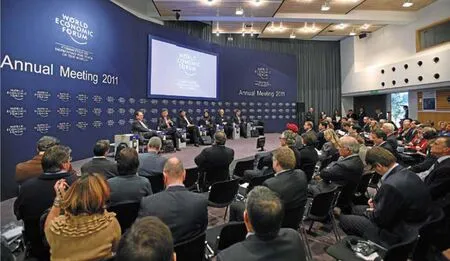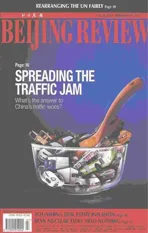Insight On ceconomic Future China becomes a hot topic at the 2011 Davos forum
2011-11-17ByHUYUE
By HU YUE
Insight On ceconomic Future China becomes a hot topic at the 2011 Davos forum
By HU YUE
When more than 2,500 global government and business leaders and economists gathered in Davos, Switzerland for the World Economic Forum (WEF), January 26-30,many of them probably had the same question in mind: Is the world economic recovery sustainable?
The economic landscape is mixed.Developed countries are struggling to manage deflationary forces while emerging economies have swiftly escaped the quagmire. China, in particular, has steered a steady course through challenging economic times.
It’s true the world economy is in a much better position than many expected a year ago. The U.S. economy, the largest in the world, is seeing light at the end of the tunnel as consumers open up their wallets again.Although Europe is buckling under a mountain of debt, it has so far avoided the worstcase scenario—a collapse of the euro.
But pessimists are worried the fi nancial crisis was not just a temporary, cyclical downturn, but the beginning of a prolonged downturn.
Given continued economic uncertainty and trouble, many people looked to the fi veday meeting—which adopted the theme“Shared Norms for the New Reality”—for insight on the world’s economic future.
According to Kalus Schwab, founder and Chairman of the WEF, “the world has fundamentally changed, and this is the new reality.”Schwab noted that an important aspect of this new reality is China’s rise.
China was well-represented in Davos.With its economy gaining clout, China sent its largest delegation ever to this year’s forum, spearheaded by business leaders seeking to succeed on a world stage previously dominated by Western companies.
Robert Greenhill, WEF’s Chief Business Of fi cer, said China’s importance at Davos is“a re fl ection of the accelerated leadership of China in the global and economic and intellectual discussions.”
The WEF invited the first Chinese delegation to Davos in 1979. In September 2007, it held the fi rst Summer Davos forum in China as the world showed an increasing interest in the vibrant Chinese economy.
Bright outlook
Even during the worst periods of the fi nancial crisis, China’s economy was widely viewed as an island of stability.
The Chinese economy has obviously found its feet, reducing the possibility of a double dip as post-crisis stimulus measures are withdrawn, said Zhu Min, a senior advisor at the International Monetary Fund (IMF) and former Vice Governor of the People’s Bank of China.
He said China has become a signi fi cant growth engine for the world economy, and he expects the Chinese economy to grow 9.5 percent in 2011.
“But the country still has a long way to go to readjust its economy to rely more on domestic demand,” he said. “After all,the economy remains heavily reliant on fixed-asset investments like infrastructure construction and real estate development,which are unsustainable.”
Zhu also suggested China make a push into hi-tech and capital-intensive sectors and move some labor-intensive businesses to western regions.
But China has woes of its own. Due to a two-year lending spree, a fl ood of low-interest credit has found its way into the economy,fueling in fl ationary jitters and property market fever across the country. Worse still, fears are proliferating that unbridled printing of dollars in the United States will compound China’s in fl ationary headache.
Liu Mingkang, Chairman of the China Banking Regulatory Commission, said policy-makers are concerned about in fl ation and will take measures to curb the consumer price surge. But the government has not set any target for new loans this year, he said.
Liu added that China is pushing forward structural reforms to make its economy“lighter and greener.”
Li Daokui, adviser to the Monetary Policy Committee of the People’s Bank of China and Director of the Center for China in the World Economy at Tsinghua University,said it is necessary to further increase interest rates and allow the yuan to gain about 5 percent in value annually to rein in in fl ation and combat the surge in property prices.
The real estate bubble is the biggest danger to China, a thousand times worse than in fl ation, he said.
Nouriel Roubini, a renowned economist and professor at New York University,agreed. He said an asset bubble could be forming in the real estate markets.
“I don’t think China is going to have a hard landing, but certainly this tradeoff between maintaining high growth and controlling in fl ation is going to be a serious policy challenge,” he said.
China has to keep a vigilant eye on hot money inflows, said Yu Yongding,a renowned researcher with the Chinese Academy of Social Sciences.
He said U.S. policymakers have left the door open for an even bigger capital injection,driving more capital into emerging markets.
Trade dynamism
Since China joined the World Trade Organization (WTO) 10 years ago, China’s vibrant foreign trade sector has been an important engine for economic growth.
The decade after WTO accession proved to be one of China’s best periods for de-velopment, said Chen Deming, Minister of Commerce.

FOCUSING ON CHINA:Participants discuss China’s innovation policies,legal reform,the future of real estate and the impact of China at the session“Insights on China” at the Annual Meeting of the World Economic Forum in Davos,Switzerland on January 26

CHINA’S VOICE: Chen Deming, Minister of Commerce, attends a press conference on the 10th anniversary of China’s entry into the WTO during the Annual Meeting of the World Economic Forum in Davos, Switzerland on January 27
Chen described China’s entry into the WTO as a “courageous and tough choice,”but de fi nitely the right decision.
In the past decade, China has opened up more than 100 service trade sectors and lowered its average duty rate to 9.8 percent from 15.3 percent a decade ago, said Chen.
China became the world’s largest importer in 2010, with the value of imports surging 38.7 percent year on year to nearly $1.4 trillion, accounting for 10 percent of the world’s total.
Over the next 10 years, China’s imports will keep increasing at an annual rate of 15 percent, and surpass the current global trade volume in 2020, he said.
Chen also outlined China’s plans to further open up its economy, bolster imports, stimulate domestic consumption and encourage Chinese companies to go global.
“China will also do its best to see the WTO’s difficult Doha Round through to a successful conclusion,” he said.
A policy of more trade and openness to the rest of the world has brought signi fi cant benefits to China and greater market opportunities to its trading partners, said Pascal Lamy, Director General of the WTO.
He noted that China joined the WTO under terms much tougher than for any other developing country—a bitter pill with industrial tariffs four times lower than Brazil or India,and agricultural tariffs lower than the European Union. The pill, though, was “an insurance policy against protectionism,” said Lamy.
Regarding China’s trade imbalance,Lamy said it is necessary to change the way we look at trade fi gures.
“Today, we calculate trade flows on a gross rather than value-added basis, which to a large extent does not give a true picture of how a nation trades,” he said.
In China’s case, Lamy said, a large part of China’s export activities involve fi nal assembling.
Products assembled in China use inputs exported to China. This inputs make up the bulk of the product’s added value, he said.
“Even if China’s contribution to the added value of a finished product is rather small, customs of fi cials in the United States,Europe, Japan or elsewhere still record 100 percent of the value of the product as an import from China. That misrepresents the true nature of trade fl ows,” he said.
“The WTO would not be the World Trade Organization without China,” said Lamy, who stressed China’s contribution to greater stability and sustainability of the global trading system.
“We saw this during the crisis when all other areas of the global economy were shaken and the trading system stood fi rm,” he said.
Fate of the yuan
The yuan should be included in the basket of the Special Drawing Rights (SDRs), the IMF’s unit of account, said French Finance Minister Christine Lagarde.
“It is quite bizarre that the Chinese currency is not part of the SDR basket, because China is the second largest economy in the world, and a top exporter of goods and services,” he said.
It has become a global consensus to allow the yuan to enter the SDR, which will help improve the stability of the U.S. dollar-based international system, said Zhu.
But that will be a long process with many technical barriers, such as the convertibility of the yuan, he said.
The world has realized the importance of China’s economy, as well as its currency, said Zhu.
If the yuan becomes fully convertible,Nigeria is willing to take it as one of its reserves currencies, said Sanusi Lamido Sanusi, Nigerian Central Bank Governor.
China has been sparing no effort to extend the global reach of the yuan. In its latest move,the government launched a trial program to allow quali fi ed Chinese companies to settle their overseas direct investments in the yuan.
杂志排行
Beijing Review的其它文章
- Cooling the Property Fever China announces toughest-ever regulations to tame the sizzling housing market
- Charm of Purple Clay A private museum in Wuxi is devoted to purple-clay art
- FINGDING A WAY OUT CITIES CARRY OUT DISTINCT STRATEGIES IN BATTING WITH THE EXACERBATING TRAFFIC JAM
- More Cars, More Burden
